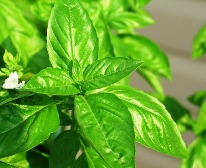It may be the Feast of the Exaltation of the Cross, but it is also a Friday. Festive penance is in order. Or, if you prefer, penitential festivity.
A fine meal for a Friday with a feast such as the Exaltation of the Cross, and the 11th anniversary of Summorum Pontificum going into force could involve … pesto.
As I have posted about pesto in the past, I opportunely repost this pesto piece:
The aromatic herb, basil (Ocimum basilicum) has long been associated with the Holy Cross.
Etymologically, it is related to basileios, the Greek word for king. [Great connection!]
According to a pious legend, the Empress Saint Helena found the location of the True Cross by digging for it under a colony of basil. Basil plants were reputed to have sprung up at the foot of the Cross where fell the Precious Blood of Christ and the tears of the Mother of Sorrows.
A sprig of basil was said to have been found growing from the wood of the True Cross.
On the Feast of the Exaltation of the Holy Cross it is customary in the East to rest the Holy Cross on a bed of basil before presenting it to the veneration of the faithful.Also, from the practice in some areas of strewing branches of basil before church communion rails, it came to be known as Holy Communion Plant Blessed basil leaf can be arranged in a bouquet at the foot of the crucifix; the dried leaves can also be used by the faithful as a sacramental.
V. Our help is in the name of the Lord.
R. Who made heaven and earth.Let us pray.
Almighty and merciful God,
deign, we beseech You, to bless
Your creature, this aromatic basil leaf. +
Even as it delights our senses,
may it recall for us the triumph of Christ, our Crucified King
and the power of His Precious Blood
to purify and preserve us from evil
so that, planted beneath His Cross,
we may flourish to Your glory
and spread abroad the fragrance of His sacrifice.
Who is Lord forever and ever.R. Amen.
The bouquets of basil leaf are sprinkled with Holy Water.
Here is the entry, with my translation, in the Martyrologium Romanum for the Feast of the Exaltation of the Holy Cross:
Festum exaltationis Sanctae Crucis, quae, postridie dedicationis basilicae Resurrectionis super sepulcrum Christi erectae, exaltatur et honoratur, sicut victoriae eius paschalis tropaeum et signum in caelo appariturum, alterum adventum eius iam universis praenuntians.
Would you all like to have a try at rendering this into flawless and yet smooth English?
Our wonderful Lewis & Short says that a tropaeum is “a sign and memorial of victory, a trophy; orig. a trunk of a tree, on which were fixed the arms, shields, helmets, etc., taken from the enemy; afterwards made of stone and ornamented in the same manner”. So, a tropaeum is a kind of war memorial.
To my mind there are echoes here of the magnificent hymn of Venantius Fortunatus, the Vexilla Regis prodeunt …
Vexilla regis prodeunt,
fulget crucis mysterium,
quo carne carnis conditor
suspensus est patibulo.
I think there is also a “once and future” reference to the vision Constantine had of the Cross before his victory over Maxentius. Constantine would later build the Basilica of the Holy Sepulcher. The future dimension is, of course, the appearance of the Lord in the East at the Second Coming (a great reason to celebrate Mass ad orientem).
(Any references to Basil in this post and similarity to digital hamsters are purely coincidental.)
Biretta tip to Vultus Christi.

 The aromatic herb, basil (Ocimum basilicum) has long been associated with the Holy Cross.
The aromatic herb, basil (Ocimum basilicum) has long been associated with the Holy Cross.
































That settles it then…. dinner will be caprese with the last of the best red and green from the garden and a fresh salmon from the Sound.
Many years ago a Melkite priest (Arab Greek Catholic) was interviewed on the radio by a Ukrainian woman in Winnipeg about being Eastern Catholic. He explained this about the basil. She said “we don’t have that in Ukraine.” He said “what would you have?” and she said “cabbage and garlic”! Very different olfactory experience! Also of note – this is one of the 2 Great Feasts of the Byzantine tradition that is kept as a fast day, the other being the Beheading of St John the Forerunner.
My best friend is from Argentina, so, at first, I was excited to have an Argentine pope, but now he has turned into the worst nightmare as a ‘pope,’ if he is one.
“Sinossi
The title of this book is one of the famous and uncomfortable answers, through which-according to the four evangelists? the Apostle Saint Peter denied Our Lord, on the twilight of the day he was captured. It is applied to Jorge Mario Bergoglio, who became Francisco when the year began in 2013. This is the situation in which here and now we have
the impression of being immersed. Iscariotism does not seem enough to intellectively know the evil that makes us tremble. It is no longer just a sly kiss and thirty smudged coins.
There is more. Whoever works for Peter has all the signs that he does not know Christ. Who knows Christ can not remain indifferent before this strange Peter who deserves every day, after a new trapisonda of his inexhaustible repertoire, the cry of the Son demanding the irrevocable Vade retro Satan!
Here our limited pretension is centered. In trying to reflect on this dramatic transit that we are suffering; and that, we insist, although it has antecedents and it is never convenient to hide them, today it has reached a peak that is chasm. This is, speaking in paradoxes, at the top of the lowest.”